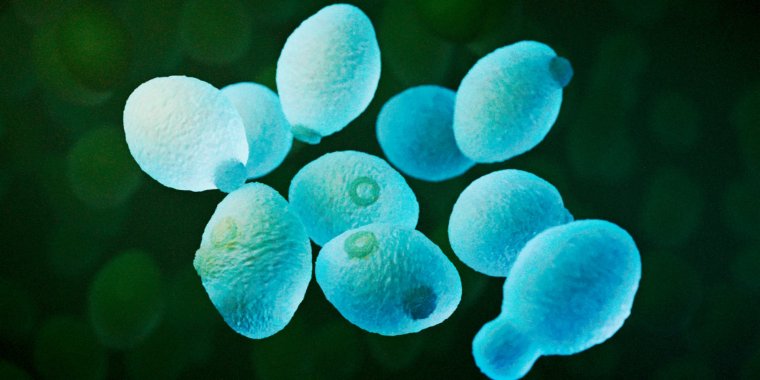| Health / Health News |
Researchers discover new gene involved in a toxic competition among yeast
National Institutes of Health researchers have identified a gene that makes yeast resistant to a lethal toxin, according to a new study. To study the evolution of toxin resistance, researchers at the National Human Genome Research Institute (NHGRI), part of NIH, used yeast— the kind commonly used for home baking — as a model organism. While researchers have long known about yeast’s remarkable ability to evade the effects of lethal toxins, the reason was a mystery until now.

Newly discovered gene helps some yeast endure toxins and can help scientists understand toxin resistance. Photo: Ernesto Del Aguila III, NHGRI/NIH
“The intricacies of genomics that mediate these within-species battles are beautifully revealed by a study like this,” said Charles Rotimi, Ph.D., scientific director of the Intramural Research Program at NHGRI. “While this is a yeast story, the mechanisms will surely influence studies on toxins and their effects on humans.”
Throughout human history, people have combatted various toxins made by other organisms, like spiders, plants, snakes and even the cholera or anthrax bacteria. Understanding toxin resistance in yeast could lead to new avenues for protection against toxins in humans.
“We’re interested in understanding how genomic variation leads to differences between individuals, so in this study, we’re looking at the most basic biological mechanisms underlying resistance to toxins in simple organisms, such as yeast,” said Meru Sadhu, Ph.D., an investigator in the Genetic Disease Research Branch at NHGRI and senior author of the study. “An important way that organisms vary is in how much they’re affected by toxins.”
Typically, toxins are used in conflicts between different species. However, these “killer” yeast are interesting and safe to study because the toxins only affect other yeast and do not harm humans, said Ilya Andreev, a former NHGRI postbaccalaureate trainee who led this study.
“There are very few examples of these within-species conflicts in nature, and our work has just scratched the surface of understanding the evolutionary dynamics of such conflicts,” Andreev added.
In this current study, NHGRI researchers analyzed yeast infected with a virus that causes the yeast to secrete a lethal toxin called K28. The virus does not negatively affect the infected yeast. Instead, infected yeast are also resistant to the toxin’s effects.
These infected yeast secrete the K28 toxin to wipe out non-infected yeast growing nearby. This provides the infected yeast an evolutionary advantage in the competition for resources. However, some non-infected yeast grow despite the presence of the toxin.
To find out how these non-infected yeast resist the toxin, the researchers exposed different non-infected yeast to the K28 toxin. Those unaffected by the toxin were classified as highly resistant and the affected ones as sensitive.
Then, the researchers compared the genomes of resistant versus sensitive yeast to identify which genes cause some yeast to be resistant.
Through this investigation, the researchers determined that the KTD1 gene provides resistance to the K28 toxin. “This gene has never been studied before,” said Sadhu. “Identifying this gene is the first step to fully understanding what is happening on the molecular level.”
The researchers then attached a glowing protein to the KTD1 protein to track its position in the yeast cells. They found that the KTD1 protein resides on the surface of cellular compartments called vacuoles. Vacuoles serve many purposes in the cell, including isolating and breaking down harmful substances like toxins.
To inflict its toxic effects, the K28 toxin must move freely around the cell. The researchers hypothesized that the KTD1 protein may be involved in capturing the toxin in the vacuole.
A region of the KTD1 protein pokes into the center of the vacuole, where it could interact with trapped toxins. By analyzing the protein sequence, the researchers found that this region of the KTD1 protein is under strong evolutionary pressures.
These strong evolutionary pressures point to this region’s importance for the KTD1 protein’s function and highlight the competition between the toxin and the yeast.
However, more research is needed to understand how this region of the KTD1 protein keeps K28 in check and how K28 may evolve in response. (National Institutes of Health)
YOU MAY ALSO LIKE





